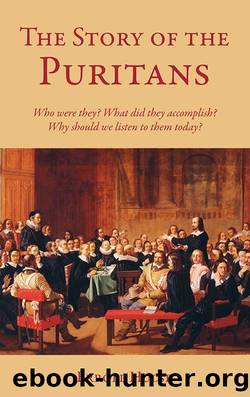The Story of the Puritans by Erroll Hulse

Author:Erroll Hulse
Language: eng
Format: mobi
Publisher: Chapel Library
Published: 2013-11-24T07:00:00+00:00
3. THE FULL FLOWERING OF PURITANISM
from 1603 to 1662
This period from 1603 to 1662 was turbulent, a time when conflict between Crown and Parliament came to a climax in the civil war. Religious pluralism surfaced in the 1640s. The story of the Puritans reached its apex in this period, especially as is seen in the Westminster Assembly. It is vital to know the history which we will now sketch in five phases.
James I
Charles I and Archbishop Laud
Civil War and the Rise of Oliver Cromwell
The Puritan Ascendancy
The Restoration of the Monarchy and the Decline of Puritanism.
James I
Elizabeth I died in 1603. She had purposed to make England great, and in that she saw success to considerable measure. Despite her personal tantrums, sulks and irrationalities, her reign was a period of political stability, especially so in the light of what was to follow in the mid-17th century. As already noted, at the beginning of the 17th century the Puritans represented about ten percent of the body of Church of England clergy.
The Puritans fostered high hopes that James (James VI of Scotland, James I of England), coming from Presbyterian Scotland, would herald Church reform. They were sadly disappointed. A petition known as the Millenary Petition, believed to represent about 1,000 Puritans, was presented to James I on his way from Scotland to London. This petition urged reformation and led to the conference known as the Hampton Court Conference. This took place on three separate days in January 1604 at Hampton Palace in London. James was highly intelligent. He understood well the intricacies of Church government. He believed in the “divine right of kings,” that is, to disobey the king is to disobey God. James had every intention of maintaining supreme power having had enough of cantankerous Presbyterians in Scotland. It was clear as daylight that the Puritans wished to “Presbyterianize” the Church of England. As the Hampton Court Conference went on, so King James became more and more bad tempered. He made dogmatic assertions such as, “No bishop, no king!” and “Presbytery agrees as much with monarchy as God with the Devil!” And to the Puritan divines he said, “You had better hurry up and conform or you will be harried out of the land!” The conference ended in a right royal flurry of bad temper! The King was agreeable to a new translation of the Bible known as The Authorized Version (or King James Version) which was completed in 1611. Otherwise, concessions were few and insignificant.
Between 1604 and 1609 about eighty clergy were deprived of their livings for their non-conformity, most of these before 1607. The bishops had been told to persuade rather than coerce subscription to Anglican practice. In Parliament, the godly campaigned for the reinstatement of deprived ministers.24
King James sent delegates to Dort. Held in 1618-19 in The Netherlands, the Synod of Dort is an important event in the history of the Christian Church. The conference affirmed the orthodox Calvinist position on the sovereignty of God over against the tenets of Arminianism.
Download
This site does not store any files on its server. We only index and link to content provided by other sites. Please contact the content providers to delete copyright contents if any and email us, we'll remove relevant links or contents immediately.
The 5 Love Languages: The Secret to Love That Lasts by Gary Chapman(9695)
The Space Between by Michelle L. Teichman(6891)
Assassin’s Fate by Robin Hobb(6162)
Wiseguy by Nicholas Pileggi(5707)
Everything Happens for a Reason by Kate Bowler(4700)
Gerald's Game by Stephen King(4607)
Pillow Thoughts by Courtney Peppernell(4241)
A Simplified Life by Emily Ley(4129)
The Power of Positive Thinking by Norman Vincent Peale(4029)
Harry Potter and the Prisoner of Azkaban (Book 3) by J. K. Rowling(3323)
Resisting Happiness by Matthew Kelly(3322)
Girl, Wash Your Face by Rachel Hollis(3250)
Being Aware of Being Aware by Rupert Spira(3247)
The Code Book by Simon Singh(3131)
The Secret Power of Speaking God's Word by Joyce Meyer(3065)
More Language of Letting Go: 366 New Daily Meditations by Melody Beattie(2999)
Real Sex by Lauren F. Winner(2986)
Name Book, The: Over 10,000 Names--Their Meanings, Origins, and Spiritual Significance by Astoria Dorothy(2960)
The Holy Spirit by Billy Graham(2914)
